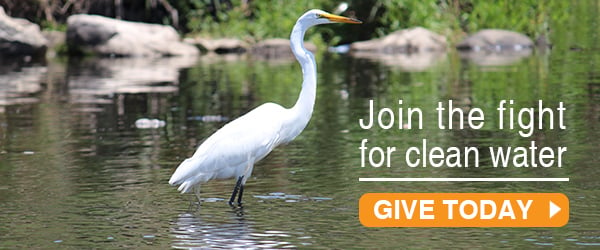Visit and enjoy the best source of drinking water in NY (Hint: It’s not from a bottled water factory)

Ashokan Reservoir
View more images on our Flickr site

Ashokan Reservoir, Leah Rae/Riverkeeper
Over the past century, New York City has spent billions of dollars to acquire lands to create a world-class drinking water system. It now provides safe drinking water to more than 9 million New York residents. The watershed includes more than 70 upstate communities in Ulster, Orange, Putnam, and Westchester counties. It provides, on average, 110 million gallons of drinking water per day.
The water travels up to 125 miles to reach us from the Catskill, Delaware, and Croton systems. In total, it is made up of 19 reservoirs, three controlled lakes, and numerous tunnels and aqueducts located on both sides of the Hudson River. In the Catskills, these lands are over six times the size of Manhattan. It is like exploring an area the size of 155 Central Parks.
The watershed protection program has been so successful that our drinking water from the Catskill area remains unfiltered. The NYC system remains one of only five large cities not required by law to filter their drinking water, including Boston, Portland, San Francisco, and Seattle. The high quality water supply produces superior drinking water, and is credited for the delicious bread products in the area, such as our world-famous bagels and pizza. Only in the last decade has the City gone to extraordinary lengths to allow public access to these amazing lands, streams, and reservoirs.
Get out and enjoy it! There is a place to go for almost every age, interest and skill level.
Our water does not just come from the tap at the sink or a water fountain. It comes from beautiful places that kids and families need to see and to enjoy:
- A popular day destination that is only a short train ride from Grand Central Station is the walkway atop of the Kensico Reservoir dam.
- Another popular family destination that is further upstate in the Catskills, with about 250,000 visits per year, is the 5 mile walkway around the Ashokan Reservoir. Visitors to this location are rewarded with spectacular views of the Catskill Mountain high peaks. There are a number of state certified outdoor guides available to assist families to get the most out of their visit. From this vantage point and from many others, it is clear protecting these lands, rivers, lakes, and streams will keep pollution from getting into these waters and degrading our drinking water.
- The watershed lands also provide countless opportunities for boating. It’s adventurer friendly. For those that enjoy occasional boating in Central Park, the Catskill area watershed lands provide incredible options. Four reservoirs now allow folks to use kayaks, canoes, sculls, and small sailboats. Over 3,000 boating trips have taken advantage of public access to the Cannonsville, Pepacton, Neversink and Schoharie Reservoirs. The success, in part, is due to the new ability to rent boats when you get there.
- American fly-fishing was born in the Catskill Mountains. These same lands also have 210 miles of stream banks for fishing. In fact, the preserved lands of the watershed boast reservoirs, ponds, and stream acreage open to fishing that are equal in size to almost four islands of Manhattan. That’s a lot of area to explore and to pass time waiting for that perfect fishing story to happen to you. There are over 12,000 people with active permits, that appreciate these great areas.
- There are also incredible amounts of City watershed lands available to hike or to hunt. This includes almost 70,000 acres of hiking lands available in the Catskills and over 80,000 acres available for hunting. The ability to enjoy the lands around the rivers, lakes, and streams is now possible because of 10 new hiking trails, including those alongside the Cannonsville Reservoir, Diverting Reservoir in Putnam County, Palmer Hill in Andes, and along the Pepacton Reservoir in Shavertown.
In addition to increased public access to the City lands, there are expanded recreational events. For example, numerous watershed walks, cleanup efforts, and family fishing days are being held throughout the summer. These activities continue to support tourism, outdoor recreation, and increased quality of life within the City’s limits.
For more information about the events held in the watershed, please see the City’s spring newsletter and follow NYCWatershed on Facebook.

